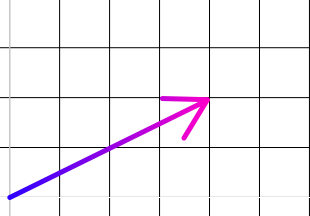Normalising a vector#
Normalising a vector is the process of making the length of a vector equal to 1, while maintaining the direction. This is called a unit vector.
Formula#
Intuition#
Building an understanding of this process. Starting out with a 2D vector \(\lt2, 4\gt\).

We can compute the hypotenuse with Pythagoras.
\(\sqrt{2^2 + 4^2} = \sqrt{20}\)
So the question then becomes, “What can I do to \(\sqrt{20}\) to make it equal to 1”. That’s an easy question to answer, just divide it by itself. BUT the catch is preserving the angle.
Working out the angle we get \(\arcsin({4 \over \sqrt{20}}) \approx 63.43\)
Our unit vector will always be a length of 1. That means our vector point will lie at 63.43 degrees on a unit circle.

To get our values we just plug in 63.43 into cosine and sine.
Which is just our values of \({4 \over \sqrt{20}}\) and \({2 \over \sqrt{20}}\).
Putting it all together we can say